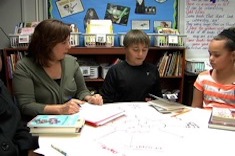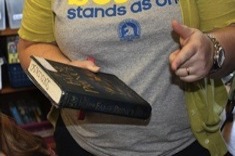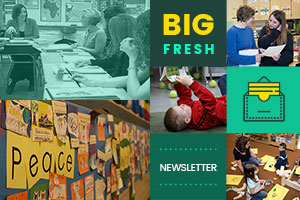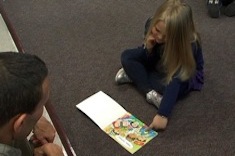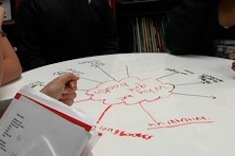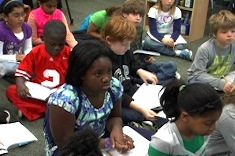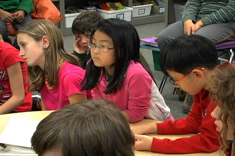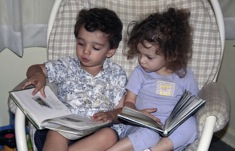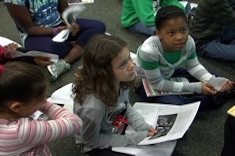Library
Choice Literacy Articles & Videos
The Choice Literacy library contains over 3,000 articles and 900 videos from 150+ contributors. Classic Classroom and Literacy Leadership subscribers have access to the entire library. Content is updated continuously, with five to six new features published each week.
Latest Content
Your Opinion Matters—Really
Gretchen Schroeder guides us in getting feedback from students, as well as sharing with students the way their feedback matters to us. In a world where we are constantly asked to fill out feedback forms, it’s good to know when our opinions matter.
Mentor Texts for “Versus” Stories
Shark vs. Train! Fork vs. Spoon! Versus stories are incredibly popular in writing workshops these days. Cathy Mere found herself struggling to teach narrative conventions to students writing versus tales, so she created a booklist of mentor texts.
On the Same Team: Better Parent-Teacher Conferences
Katherine Sokolowski has tips for improving parent conferences by using technology for flexible scheduling and easy follow-up.
Holding Thinking Minilesson with Second Graders
Deb Gaby uses an analogy of animal tracks to introduce the concept of "holding thinking" in reading journals to second graders.
Building Stamina and Book Choice Skills
Franki Sibberson continues a discussion with a small group of students who often abandon books. This is the second installment in a two-part video series.
The Art of the Book Talk
If you want to match students to books, you’ll need to master the art of the book talk. Katherine Sokolowski has practical tips for honing your skills.
The Big Fresh October 5, 2013 No Boundaries
We consider “just-right” books in this week’s Big Fresh.
The Big Fresh September 28, 2013 Teaching the Genes
Logs and notebooks are the focus of this week's Big Fresh.
Creating Your Own Kindergarten Assessment
Max Brand finds standard assessments don’t always give him the information he needs when working with kindergarten English language learners, so he develops his own tool for analyzing book handling skills.
Teaching the Genes
Suzy Kaback rethinks the concept of "managed choice" in writing workshops.
Why Write?
Ruth Ayres answers the question of why writing matters for busy teachers who struggle to find time for their own writing notebooks.
Abandoning Books Discussion
Franki Sibberson works with a small group of fourth graders who often abandon books.
October Literacy Contracts: Fear and Conflict
Megan Ginther and Holly Mueller continue their monthly series on using literacy contracts in middle school. The October literacy contracts have a theme of fear and conflict.
The Big Fresh September 21, 2013 Say Yes
Student research in the age of the Common Core is the topic of this week’s Big Fresh.
Whole-Class Research Planning
Andrea Smith leads her fourth graders through brainstorming for their owl research project.
“We Gather Together”: On Research and Weddings
Ruth Ayres and her colleagues use a marriage analogy to help middle school students and their families understand the research process. The article includes a nifty example of a pamphlet to share with parents.
Limiting and Extending Choice in Student Research Projects
When students are able to pick any research topic, they often will choose something they have already studied extensively. How can teachers allow students to pick topics for research they care passionately about and at the same time ensure there is the potential for rich inquiry? Maria Caplin describes the process she uses in her fifth-grade classroom to help students find and refine research topics for deeper learning.
Chris Lehman on Student Research (PODCAST)
Franki Sibberson chats with Chris Lehman (author of Energize Research Reading and Writing) about how the Common Core is changing the ways teachers approach student research in their classrooms.
The Big Fresh September 14, 2013 The Spotlight
Mentors near and far are the focus of this week's Big Fresh.
Writing Leads Minilesson
A writing lead is a door — readers will either want to walk through it or shut it and move on to something else. That's the analogy Karen Terlecky uses in this video of a fifth-grade writing workshop minilesson.
Keeping Kids Safe on the Internet
Julie Johnson provides helpful tips and a letter for parents to help keep students safe on the Internet.
Finding the “Ex” Factor in Explanatory Writing
Jeff Anderson launches a new series on explanatory writing, a topic of high interest to teachers now because of the Common Core.
Kidwatching and Connections in the Early Days
Cathy Mere finds the early days of school are all about kidwatching and connecting with her first-grade students during reading and writing workshops. She shares some terrific guiding questions that might also help new teachers hone their observation skills.
The Big Fresh September 7, 2013 Perfect Pie Crusts
We consider close reading in this week’s Big Fresh.
Emphasizing Empathy: September Literacy Contracts
Megan Ginther and Holly Mueller are Emphasizing Empathy in their September literacy contracts for middle school students.
How to Eat an Elephant One Bit(e) at a Time: Reading Complex Texts
Maggie Beattie Roberts and Kate Roberts present a step-by-step process for close reading in the middle and high school grades involving multiple passes through the same text.
Lessons from Listening to Toddlers Read (Home Is Where the Books Are Series)
What can you learn from having toddlers "read" to you? Plenty, as Meghan Rose soon discovers.
Chris Lehman and Kate Roberts on Close Reading (PODCAST)
Franki Sibberson chats with Chris Lehman and Kate Roberts about close reading in this 30-minute podcast. Chris and Kate are the authors of Falling in Love with Close Reading: Lessons for Analyzing Texts — and Life from Heinemann.
Owl Research: Whole Class Explanation of Marking Up Text
Students are given a nonfiction text to mark up during a close reading with a partner in this video from Andrea Smith’s fourth-grade classroom.
The Big Fresh August 31, 2013 Chasing Joy
Setting goals for students and adults is the topic of this week's Big Fresh.
Browse Content By
Type
Category
- Assessment Tools
- Big Fresh Archives
- Booklists
- Choice Numeracy
- Classroom Design
- Common Core
- Community Building
- Conferring
- Content Literacy
- Digital Literacy
- English Language Learners
- Equity
- Family Relations
- Free Samples
- Guiding Groups
- Leadership
- Literacy Coaches
- Mentor Texts
- Minilessons
- New Teacher Mentors
- Podcasts
- Poetry
- Quote Collections
- Reading Strategies
- Self Care
- Struggling and Striving Learners
- Talking and Listening
- Teacher Study Groups
- Teaching Reading
- Teaching Writing
- Word Study and Vocabulary
Author
- Melissa Quimby
- Nawal Qarooni
- Gwen Blumberg
- Julie Cox
- The Lead Learners
- Hannah Tills
- Josie Stewart
- Ruth Metcalfe
- Mallory Messenger
- Becca Burk
- Jodie Bailey
- Vivian Chen
- Mary Brower
- Tiffany Abbott Fuller
- Stephanie Affinito
- Ruth Ayres
- Leigh Anne Eck
- Heather Fisher
- Shari Frost
- Julie Johnson
- Suzy Kaback
- Gigi McAllister
- Shirl McPhillips
- Melanie Meehan
- Cathy Mere
- Debbie Miller
- Tara Barnett and Kate Mills
- Tammy Mulligan
- Dana Murphy
- Bitsy Parks
- David Pittman
- Brenda Power
- Heather Rader
- Matt Renwick
- Mandy Robek
- Christy Rush-Levine
- Gretchen Schroeder
- Jen Schwanke
- Brian Sepe
- Katherine Sokolowski
- Stella Villalba
- Jennifer Vincent
Grade Level
Choice Literacy Membership
Articles
Get full access to all Choice Literacy article content
Videos
Get full access to all Choice Literacy video content
Courses
Access Choice Literacy course curriculum and training





